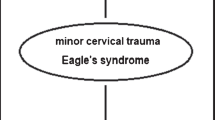Abstract
Introduction
Vascular Eagle syndrome, due to impingement of the extracranial internal carotid artery (ICA) by the styloid process (SP), is an uncommon and not yet widely recognized cause of ICA dissection.
Up to now, this diagnosis is still presumptive, based mainly on the length of the SP.
However, given the discrepancy between the much higher prevalence of an elongated SP in the population compared to the reported rate of Eagle syndrome, other anatomical factors beyond the length itself of this bony structure seem to be involved.
Material and methods
We performed a retrospective single center case–control study of ICA dissection related to abnormalities of styloid process and age- and sex-matched controls affected by ICA dissection not related to abnormal relationship with the styloid process. In our work instead of considering SP length as the main criteria to differentiate the two groups, we decided to consider styloid process-internal carotid artery distance (at the dissection point) as the main factor to define a styloid process related dissection (SPRD). In fact in some patients, the distance between the dissected artery and the bony prominence was virtual.
Results
Our study showed that in patients with SPRD the styloid process angulation on the coronal plane tends to be more acute and that styloid process-C1 distance is significantly shorter at the side of the dissection.
This data reinforces the idea that ICA dissection risk in the vascular Eagle syndrome has probably a multifactorial pathogenesis.


Similar content being viewed by others
Data availability
We certify that this manuscript is a unique submission and is not being considered for publication, in part or in full, with any other source in any medium. All patients’ data have been anonymized.
Code availability
Not applicable.
References
Eagle WW (1949) Symptomatic elongated styloid process; report of two cases of styloid process-carotid artery syndrome with operation. Arch Otolaryngol 49:490–503. https://doi.org/10.1001/archotol.1949.03760110046003
Chuang WC, Short JH, McKinney AM, Anker L, Knoll B, McKinney ZJ (2007) Reversible left hemispheric ischemia secondary to carotid compression in Eagle syndrome: surgical and CT angiographic correlation. AJNR Am J Neuroradiol 28:143–145
Qureshi S, Farooq MU, Gorelick PB (2019) Ischemic stroke secondary to stylocarotid variant of Eagle syndrome. Neurohospitalist 9(2):105–108. https://doi.org/10.1177/1941874418797763
Renard D, Tatu L (2018) Anatomical relationship between carotid artery and styloid and hyoid bones in patients showing unintended head rotation on CTA. Acta Neurol Belg 118:597–602. https://doi.org/10.1007/s13760-018-1008-7
Infante-Cossio P, Garcia-Perla A, Gonzalez- Garcia A, Gil-Peralta A, Gutierrez-Perez JL (2004) Compression of the internal carotid artery due to elongated styloid process [in Spanish]. Rev Neurol 39:339–343
Farhat HI, Elhammady MS, Ziayee H, Aziz-Sultan MA, Heros RC (2009) Eagle syndrome as a cause of transient ischemic attacks. J Neurosurg 10:90–93. https://doi.org/10.3171/2008.3.17435
Kaufman SM, Elzay RP, Irish EF (1970) Styloid process variation. Radiologic and clinical study Arch Otolaryngol 91:460–546. https://doi.org/10.1001/archotol.1970.00770040654013
Correll RW, Jensen JL, Taylor JB, Rhyne RR (1979) Mineralization of the stylohyoid-stylomandibular ligament complex: a radiographic incidence study. Oral Surg Oral Med Oral Pathol 48:286–291. https://doi.org/10.1016/0030-4220(79)90025-2
Raser JM, Mullen MT, Kasner SE, Cucchiara BL, Messe SR (2011) Cervical carotid artery dissection is associated with styloid process length. Neurology 77(23):2061–2066
Renard D, Azakri S, Arquizan C, Swinnen B, Labauge P, Thijs V (2013) Styloid and hyoid bone proximity is a risk factor for cervical carotid artery dissection. Stroke 44(9):2475–2479. https://doi.org/10.1161/STROKEAHA.113.001444
Baldino G, Di Girolamo C, De Blasis G, Gori A (2020) Eagle syndrome and internal carotid artery dissection: description of five cases treated in two Italian institutions and review of the literature. Ann Vasc Surg 67:565.e17-565.e24. https://doi.org/10.1016/j.avsg.2020.02.033
Langlais RP, Miles DA, Van Dis ML (1986) Elongated and mineralized stylohyoid ligament complex: a proposed classification and report of a case of Eagle’s syndrome. Oral Surg Oral Med Oral Pathol 61:527–532. https://doi.org/10.1016/0030-4220(86)90400-7
Torikoshi S, Yamao Y, Ogino E, Taki W, Sunohara T, Nishimura M (2019) A staged therapy for internal carotid artery dissection caused by vascular Eagle syndrome. World Neurosurg 129:133–139. https://doi.org/10.1016/j.wneu.2019.05.208
Mattioli P, Baldino G, Castaldi A, Gandoglia I, Del Sette M (2020) A peculiar case of internal carotid dissection: “do not forget Eagle’s syndrome!” Neurol Sci. https://doi.org/10.1007/s10072-020-04925-1
Amorim JM, Pereira D, Rodrigues MG, Beato-Coelho J, Lopes M, Cunha A, Figueiredo S, Mendes-Pinto M, Ferreira C, Sargento-Freitas J, Castro S, Pinho J (2018) Anatomical characteristics of the styloid process in internal carotid artery dissection: case-control study. Int J Stroke 13(4):400–405. https://doi.org/10.1177/1747493017730779
Callahan B, Kang J, Dudekula A, Eusterman V, Rabb CH (2010) New Eagle’s syndrome variant complicating management of intracranial pressure after traumatic brain injury. Inj Extra 41:41–44
Ho S, Luginbuhl A, Finden S, Curry JM, Cognetti DM (2015) Styloid/C1 transverse process juxtaposition as a cause of Eagle’s syndrome. Head Neck 37:E153–E156. https://doi.org/10.1002/hed.24024
Ilgu ̈y M, Ilgu ̈y D, Gu ̈ler N, Bayirli G (2005) Incidence of the type and calcification patterns in patients with elongated styloid process. J Int Med Res 33:96–102. https://doi.org/10.1177/147323000503300110
Schievink WI, Mokri B, O’Fallon WM (1994) Recurrent spontaneous cervical artery dissection. N Engl J Med 330:393–397. https://doi.org/10.1056/NEJM199402103300604
Kremer C, Mosso M, Georgiadis D, Stöckli E, Benninger D, Arnold M et al (2003) Carotid dissection with permanent and transient occlusion or severe stenosis: long-term outcome. Neurology 60:271–275. https://doi.org/10.1212/01.wnl.0000043580.70857.92
Author information
Authors and Affiliations
Corresponding author
Ethics declarations
Ethical approval
None.
Conflict of interest
The authors declare no competing interests.
Ethical approval and Informed consent
All procedures followed were in accordance with ethical standards of the responsible committee of human experimentation (institution and national) and with the principles established by the 18th World Medical Assembley in Helsinki, 1964 and subsequent amendments/additional and Good Clinical Practices.
Anonymity is maintained and the patients are not indentifiable in photographs, images or tect.
Written informed consent was obtained from all patients in this study.
Additional information
Publisher's note
Springer Nature remains neutral with regard to jurisdictional claims in published maps and institutional affiliations.
Rights and permissions
About this article
Cite this article
Tardivo, V., Castaldi, A., Baldino, G. et al. Internal carotid artery dissection related to abnormalities of styloid process: is it only a matter of length?. Neurol Sci 43, 459–465 (2022). https://doi.org/10.1007/s10072-021-05350-8
Received:
Accepted:
Published:
Issue Date:
DOI: https://doi.org/10.1007/s10072-021-05350-8




